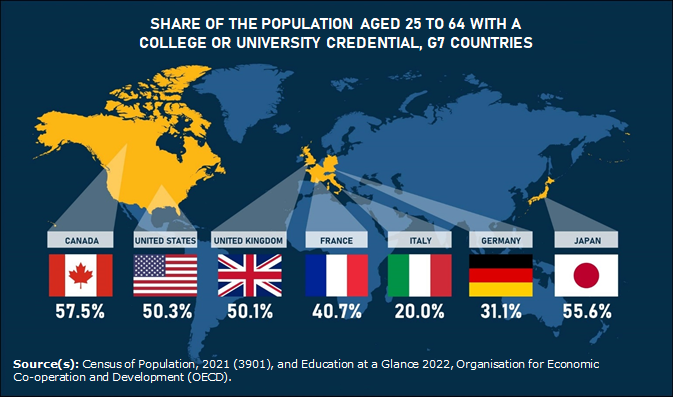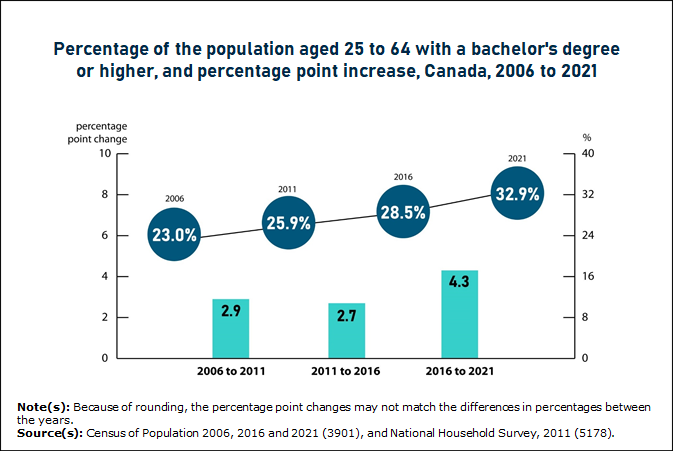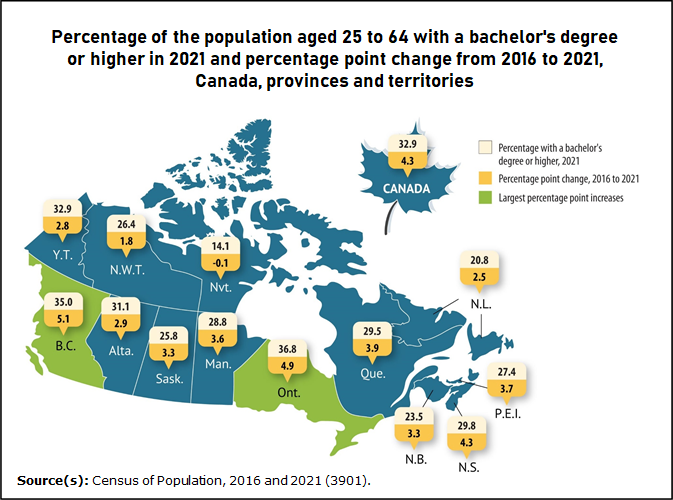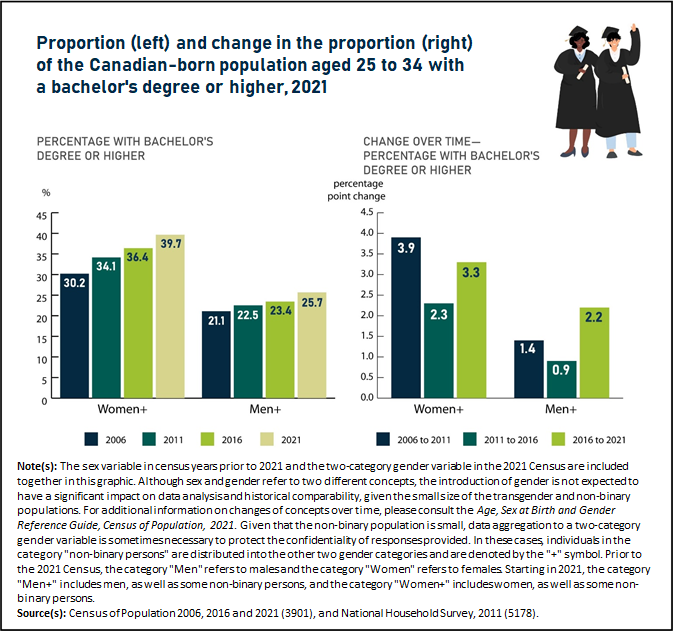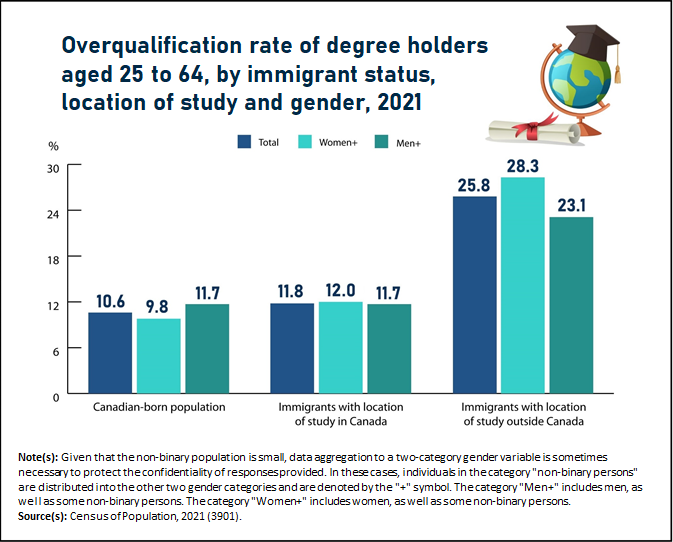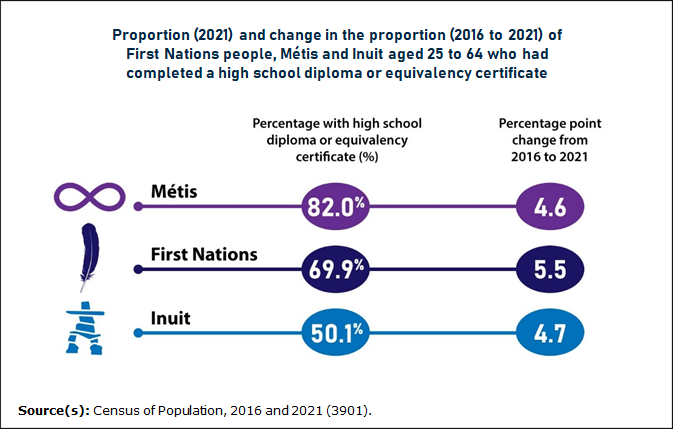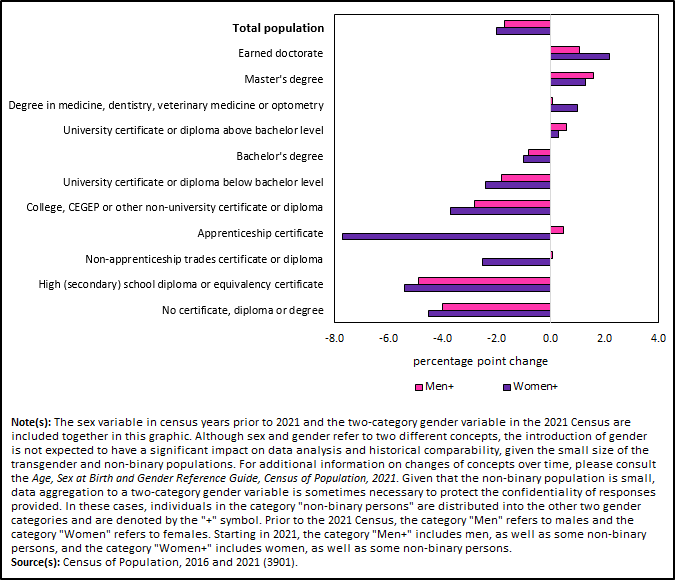Canada leads the G7 for the most educated workforce, thanks to immigrants, young adults and a strong college sector, but is experiencing significant losses in apprenticeship certificate holders in key trades
Released: 2022-11-30
A highly educated workforce is essential to maintaining our standard of living as a country, as well as meeting current and future labour market needs. Canada has a larger share of the population with a college or university credential than any other country in the G7. The share with a bachelor's degree or higher continues to rise with an influx of highly educated immigrants and a growing number of young adults completing degrees. However, we may be leaving talent on the table with the educational qualifications of some foreign-educated workers being underused.
Leveraging these credentials is important as more of the population nears retirement age. Moreover, Canada faces a labour crunch, with high employment, record-low unemployment and record-high job vacancies. Capitalizing on our highly educated population is key to ensuring that Canada has enough trained workers to fill the spaces left by retirements.
Educational attainment is also tied to job security, and the COVID-19 pandemic cast a renewed light on this. Those with higher levels of education were better positioned to withstand the economic disruptions caused by the pandemic, due in part to being more likely to work in industries that were suited to remote work. According to the Labour Force Survey, those with a bachelor's degree or higher were less likely to feel the initial unemployment shocks in April 2020, and their employment rate recovered faster, regaining pre-pandemic levels by November 2020. The employment rates of those with lower levels of education largely did not return to pre-pandemic levels until autumn 2021. Nonetheless, many frontline workers with lower levels of education were crucial to keeping Canada running during the shutdowns in the first waves of the pandemic, as they worked in areas such as grocery stores and gas stations, as cleaners, and in health care support.
Using data from the 2021 Census, today's release examines the changing face of education in Canada and the role that education and training have played in the evolution of the Canadian workforce.
Highlights
Canada continues to rank first in the G7 for the share of working-age people (aged 25 to 64) with a college or university credential (57.5%). A key factor in this is Canada's strong college sector: nearly one in four working-age people (24.6%) had a college certificate or diploma or similar credential in 2021, more than in any other G7 country.
From 2016 to 2021, the working-age population saw an increase of nearly one-fifth (+19.1%) in the number of people with a bachelor's degree or higher, including even larger rises in degree holders in the fields of health care (+24.1%) and computer and information science (+46.3%).
In contrast, the number of working-age apprenticeship certificate holders has stagnated or fallen in three major trades fields—construction trades (+0.6%), mechanic and repair technologies (-7.8%) and precision production (-10.0%)—as fewer young workers replace the baby boomers who are retiring. Job vacancies in some industries related to these trades, such as construction and fabricated metal product manufacturing, reached record highs in 2022.
Recent immigrants made up nearly half of the growth in the share of Canadians with a bachelor's degree or higher. However, some immigrants' talents remain underutilized, as over one-quarter of all immigrants with foreign degrees were working in jobs that require, at most, a high school diploma. This is twice as high as the overqualification rate for Canadian-born or Canadian-educated degree holders.
Even foreign-educated immigrants with credentials in high-demand areas such as health care faced high rates of job mismatch: 36.5% of immigrants with a foreign degree in registered nursing worked as registered nurses or in closely related occupations, and 41.1% of immigrants with foreign medical degrees worked as doctors. This compares with job match rates of approximately 9 in 10 for the population with Canadian nursing (87.4%) or medical (90.1%) degrees.
The share of Canadian-born young adults (aged 25 to 34) with a bachelor's degree or higher is also rising (+2.7 percentage points from 2016 to 2021). The increase was larger among Canadian-born young women (+3.3 percentage points, reaching 39.7%) than Canadian-born young men (+2.2 percentage points, reaching 25.7%). Nonetheless, among young men the increase in this 5-year period from 2016 to 2021 was nearly as large as the increase during the 10-year period from 2006 to 2016 (+2.3 percentage points).
Educational gaps faced by First Nations people, Métis and Inuit are narrowing at the high school level. In 2021, over half of Inuit aged 25 to 64 had completed high school, up from 45.4% in 2016. At the same time, gaps are widening at the level of a bachelor's degree or higher for all Indigenous groups.
People with credentials above the bachelor level were better able to weather the labour market shocks of the pandemic, partly due to working in industries that were more suited to remote work. They had higher employment rates and earnings in 2021 than 2016, while those with most other levels of education saw lower employment rates.
Canada has the largest share of college and university graduates in the G7
An educated population is crucial to maintaining Canada's standard of living and pace of economic growth in the coming years. Canada continues to perform strongly in terms of education on the world stage, benefitting from highly educated immigrants and a growing share of young adults graduating from a college or university.
In fact, Canada has led the G7 in terms of post-secondary graduates since 2006, with 57.5% of the working-age population (that is, those aged 25 to 64) having a college or university credential, according to new results from the 2021 Census.
Canada's strong college system is key to its high international standing. For example, nearly one in four Canadians (24.6%) had a college certificate or diploma or similar credential as their highest level of education in 2021, above all other G7 countries and more than double the share in the United States (10.8%).
Canada was in the middle of the pack in terms of the share of the population with a bachelor's degree or higher (32.9%), placing fourth in the G7 after the United Kingdom (41.3%), the United States (39.5%) and Japan (34.2%). Canada lagged other countries in the share with graduate degrees, at 9.3% (8.2% with a master's degree or equivalent and 1.1% with an earned doctorate), whereas in the other G7 countries, this share ranged from 13% to 15%.
One in three Canadians now holds a bachelor's degree or higher
A rising share of working-age Canadians has completed a bachelor's degree or higher, an increase driven both by highly educated recent immigrants and by rising educational attainment among young adults. Over 6.4 million people, or approximately one-third of the working-age population, reported having a bachelor's degree or higher in 2021, up 4.3 percentage points from 2016, a faster pace of increase than reported in the two previous censuses.
British Columbia (+5.1 percentage points) and Ontario (+4.9 percentage points) saw the largest increases in degree holders from 2016 to 2021. This was driven by two factors. First, Ontario and Western Canada welcomed more of the highly educated recent immigrants than Quebec and Atlantic Canada. Second, British Columbia (+3.3 percentage points) and Ontario (+3.1 percentage points) led the provinces in the rising share of Canadian-born young adults (aged 25 to 34), with a bachelor's degree or higher, compared with the rest of Canada (+2.7 percentage points).
Women remained more likely than men to have a bachelor's degree or higher: for example, 39.7% of Canadian-born young women (aged 25 to 34) had a degree in 2021, compared with 25.7% of Canadian-born young men. However, the share of Canadian-born young men with a degree rose more quickly than in the past. The 5-year increase from 2016 to 2021 in the share of these men with a degree (+2.2 percentage points) was almost as large as the 10-year increase (+2.3 percentage points) from 2006 to 2016. While the increase among Canadian-born young women from 2016 to 2021 (+3.3 percentage points) was larger than that of young men, it was similar to previous years.
In Quebec, the acceleration in young men's completion of a bachelor's degree or higher was particularly pronounced. In 2021, 23.4% of young men in Quebec had a bachelor's degree or higher, up 2.2 percentage points from 2016. This 5-year increase was larger than the 10-year increase (+1.5 percentage points) from 2006 to 2016.
Varied educational pathways: One-quarter of Ontario college students have a previous bachelor's degree
As the number of bachelor's degree holders rises, colleges' role in higher education has diversified, as some college programs are targeted at complementing a bachelor's degree with specific job-related skills.
Approximately one-quarter of college students in Ontario and British Columbia during the 2020/2021 school year had already obtained a bachelor's degree. Both of these provinces have college programs that are specifically geared towards bachelor's-degree holders to build on their degrees in ways that are directly applicable to the labour market.
These college programs frequently add to, and are related to, the previous bachelor's degree. For example, those with a registered nursing degree who take college programs tend to study registered nursing specializations like critical care nursing, while those with degrees in business, the humanities or the social and behavioural sciences study fields such as human resources, public relations or advertising.
Post-bachelor's-degree college programs also have particular appeal to immigrants, since they can often build upon foreign degrees. More than one-third of immigrants studying at Canadian colleges had a prior bachelor's degree or higher (27.4% with a foreign degree and 9.2% with a degree completed in Canada).
Some colleges are also offering bachelor's degree programs. The Postsecondary Student Information System reported that 3.7% of graduations with an undergraduate degree in 2019 were from colleges.
Fewer working-age people with apprenticeships in key trades fields in 2021 compared with five years earlier, amid record-high labour demand and retirements
Over two-thirds (70.4%) of apprenticeship certificates in 2021 were in the key fields of construction trades (such as carpenters, electricians and plumbers), mechanic and repair technologies (auto mechanics) and precision production (welders). The total number of working-age people with apprenticeships declined in mechanic and repair technologies (-7.8%) and precision production (-10.0%) from 2016 to 2021 and stayed relatively level in the construction trades (+0.6%), as the number of younger entrants could not replace those retiring quickly enough. This contrasts sharply with a rise of nearly one-fifth (+19.1%) in the number of working-age people who have a bachelor's degree or higher and poses a serious challenge for industries relying on the skilled trades. In 2021 and 2022, the demand for skilled trades workers reached record highs. Job vacancies in the occupational category of "trades, transport and equipment operators and related occupations" that required at least a trades or apprenticeship credential nearly doubled from late 2019 to late 2021. Likewise, job vacancies in some related industries such as construction and fabricated metal product manufacturing reached record highs in 2022.
This trend can be expected to continue over the next decade as baby boomers march towards retirement. For example, in 2021, 3 in 10 employed people (30.2%) with an apprenticeship in mechanic and repair technologies or precision production were aged 55 or older. In the construction trades, this share was 22.1%, similar to the average for all employed people (23.0%), but with demand for housing remaining high, the construction sector is nonetheless facing major labour shortages.
The trends in the field of construction differed by province. Quebec, Manitoba, Saskatchewan and British Columbia saw increases in the number of people with an apprenticeship certificate in the construction trades (ranging from increases of 4.6% to 8.3%), while the Atlantic provinces, Ontario (-3.8%) and Alberta (-3.5%) experienced decreases.
The number of potential workers in the trades fields of construction trades, mechanic and repair technologies, and precision production has been limited by the underrepresentation of women, racialized groups and immigrants. Women made up 2.4% of working-age apprenticeship certificate holders in these fields in 2021. Racialized groups as a whole made up 7.1% of working-age apprenticeship certificate holders in these trades, whereas they made up 27.3% of the total working-age population. Latin Americans were the racialized group with the most representation in these trades relative to their share of the overall population (0.9% of apprenticeship certificate holders in these trades, compared with 1.9% of the working-age population), while Koreans were the least represented (0.1%, compared with 0.7% of the working-age population). Likewise, immigrants made up 27.7% of the working-age population, but 10.0% of apprenticeship certificate holders in these three fields.
Immigrants help raise education levels in Canada, but face higher rates of overqualification if they have a foreign degree
Immigrants play a key role in Canada's high share of degree holders. Leveraging the talents of highly educated immigrants is key to maintaining Canada's standard of living and meeting labour market needs as the population ages. In 2021, immigrants and non-permanent residents accounted for over half of the working-age population with an earned doctorate (55.8%), a master's degree (52.2%) or a degree in medicine, dentistry, veterinary medicine or optometry (50.8%), and accounted for 39.1% of those with a bachelor's degree.
Immigrants account for a larger share of the population in Canada than in any other G7 country, and the number of recent immigrants (from 2016 to 2021) in the 2021 Census, was the highest recorded in any Canadian census. In addition, these recent immigrants were more highly educated than any previous group, with nearly 6 in 10 (59.4%) holding a bachelor's degree or higher. Immigrants who had landed in Canada since the 2016 Census were responsible for nearly half (2.1 percentage points) of the 4.3-percentage-point rise from 2016 to 2021 in the share of the working-age population holding a bachelor's degree or higher.
These high levels of education, along with higher rates of Canadian work experience, have contributed to the labour market outcomes of recent immigrants. As noted in the Labour release, recent immigrants in 2021 (who landed during the period from 2016 to 2021) were more likely to be working in industries with above-average hourly wages, compared with recent immigrants in 2016 (who landed during the period from 2011 to 2016). Nevertheless, immigrants with foreign credentials (their degree was obtained outside Canada) face barriers to using their skills in Canada. Over one-quarter (25.8%) of all immigrants with a foreign degree were overqualified, which is defined as a degree holder working in a job that typically requires a high school education or less. This was more than double the overqualification rate among Canadian-born degree holders (10.6%) or immigrants with a Canadian degree (11.8%). Among immigrants with a foreign degree, overqualification was higher among women (28.3%) than among men (23.1%).
The overqualification of immigrants with foreign degrees is a longstanding issue, observed consistently since the addition of location of study data to the 2006 Census. It grows ever more salient as the number of immigrants with foreign degrees increases. In 2021, almost two-thirds (63.8%) of immigrants with a bachelor's degree or higher had completed it outside Canada.
Even immigrants with foreign degrees in high-demand areas such as registered nursing or medicine faced high rates of job mismatch. For example, 36.5% of immigrants with a foreign bachelor's degree or higher in registered nursing worked as registered nurses, or in closely related occupations such as nurse practitioners, nursing supervisors or health care managers, and 41.1% of immigrants with a foreign medical degree worked as doctors. In contrast, among the population with a Canadian nursing degree or medical degree, approximately 9 in 10 worked as registered nurses (87.4%) or doctors (90.1%).
Although the census does not tell us directly about barriers that immigrants may face to finding employment in their field, such as credential recognition and official language proficiency, results show that, if immigrants with foreign degrees had jobs in their field at the same rate as the Canadian-educated population, it could increase the potential number of working-age registered nurses and closely related occupations by 27,350, and doctors by 15,730.
Another group facing high rates of job mismatch despite being in a high-demand field were women who had studied computer and information sciences. This was the case for both immigrant women and Canadian-born women. Among the population with a postsecondary credential in computer and information science who worked in 2020 or 2021, less than one-third (31.5%) of women worked in science, technology, engineering and mathematics (STEM) occupations in mathematics, computer and information science, compared with half (50.1%) of men. This constituted a job match gap of 18.6 percentage points. The job match gap between men and women remained similar (ranging from 16 to 22 percentage points) even after taking credential type into account (below bachelor's, bachelor's degree or master's degree) and whether they studied in Canada or outside Canada. Women with computer science credentials were more likely than men with those credentials to work in other-than-STEM occupations in business, finance and administration (21.5% for women compared with 7.7% for men).
If the job match gap between women and men in computer science were eliminated (controlling for credential type and location of study), it would potentially increase the total number of working-age people working in computer science occupations by 26,340.
Increasing numbers of international students contribute to the educated labour force
The number of international students has grown rapidly in recent years, from approximately 350,000 in 2015 to approximately 620,000 in 2021, based on data on study permit holders from Immigration, Refugees and Citizenship Canada. These students commonly immigrate to Canada and make an important contribution to the educated workforce. Over two-thirds of international students who completed a college credential or a master's degree, and half of those who completed a bachelor's degree, became permanent residents within five years of graduation.
International students are also a major source of funding for colleges and universities. For example, it is estimated that international students paid almost 40% of all tuition fees and accounted for almost $4 billion in annual revenue for Canadian universities in 2017/2018.
In particular, students from India are attending Canadian colleges in increasing numbers. From 2015 to 2019, India was the top source country for international students at both colleges (66.8% of international students) and universities (21.3% of international students). This is much higher than in the period from 2000 to 2004, when India accounted for 5% or less of international students at either colleges or universities.
More Canadians hold degrees in health care compared with five years earlier, but labour shortages remain
Driven by both the health care needs of an aging population and the need to respond to the health impacts of the pandemic, the number of people working in non-management health occupations grew by 16.8% from 2016 to 2021. Likewise, the number of working-age people with a degree in health care rose by almost one-quarter (+24.1%) compared with 2016, to 691,000 in 2021, faster than the overall rise in the number of working-age people with a degree (+19.1%). This included marked increases in nursing (+29.7% to 267,000) and dentistry (+23.8% to 31,000) graduates. There were 9,500 (+9.3%) more people with a medical degree (including residencies) in 2021 compared with five years earlier.
More than three-quarters (76.2%) of the population with a health care degree who worked in 2020 or 2021 were working in health care occupations (82.1% of those with a Canadian health care degree and 63.0% of those with a foreign health care degree).
Despite the recent influx of health care graduates, the pandemic has put a tremendous strain on Canada's health care system and, in particular, on health care workers on the front lines. Hospitals and health care facilities across Canada remain thinly stretched, with job vacancies for registered nurses reaching a record high of over 23,000 by the second quarter of 2022. When Statistics Canada surveyed health care workers in the fall of 2021, nearly one-quarter (24.4%) of nurses reported intending to leave their job or change jobs within the next three years, with job stress or burnout being the most common reason for that choice.
Number of degree holders in computer science rises by over two-fifths
The pandemic saw a rise in the share of jobs that required specific technical skills related to computer science and, likewise, a rise in jobs in the computer systems design and related services industry, as a larger portion of work moved online.
The supply of skilled workers in this area has likewise been growing. Statistics Canada counted 295,000 computer and information science degree holders in 2021, up 46.3% or nearly 100,000 more than five years earlier. Postsecondary Student Information System pointed to a continuation of this trend, with university enrolments in mathematics and computer and information sciences rising by 8.4% from 2019/2020 to 2020/2021.
However, increases were not evenly distributed across the provinces. British Columbia, which had the largest overall growth in degree holders (+24.2%), saw a 51.6% rise in computer and information science degree holders from 2016 to 2021. In 8 provinces, the increase was over 40%. Conversely, the smallest gains among the provinces were in Alberta (+28.6%) and Newfoundland and Labrador (+20.3%).
Over half of Inuit have completed high school
First Nations people, Métis and Inuit are some of the youngest populations in Canada, and their current and future educational paths have important implications for Canadian society, as the population of the country as a whole ages.
First Nations people, Métis and Inuit face major gaps in high school and postsecondary completion. As of 2021, nearly three-quarters (73.9%) of working-age Indigenous people had completed high school, and 12.9% had a bachelor's degree or higher.
Gaps between the Indigenous and the non-Indigenous population are narrowing when it comes to high school completion. The share of Métis who had completed high school rose 4.6 percentage points from 2016, to 82.0% in 2021, while for First Nations people, the share increased 5.5 percentage points to 69.9%.
For the first time, in 2021, over half (50.1%) of Inuit aged 25 to 64 had completed a high school diploma or equivalency certificate, up 4.7 percentage points from 2016.
In all these cases, these increases in the share of Indigenous populations with a high school diploma were larger than among the Canadian-born non-Indigenous population (+2.0 percentage points), 88.9% of whom had completed high school. This group is used for comparison to exclude changes driven by the high education levels of recent immigrants.
However, gaps between the share of the Indigenous and the non-Indigenous population completing a bachelor's degree or higher are widening. Although the share of Indigenous people with a bachelor's degree or higher rose by 1.9 percentage points (to 12.9%) in 2021, this was less than the increase among the Canadian-born non-Indigenous population (+2.9 percentage points, to 27.8%). This trend held true among Métis (+2.5 percentage points, to 15.7%), First Nations people (+1.6 percentage points, to 11.3%) and Inuit (+0.9 percentage points, to 6.2%). This is important, since education at the bachelor level and above is associated with higher-paying jobs, and barriers to higher education faced by Indigenous people contribute to socioeconomic disadvantages.
Pandemic upends student life
Student life as we knew it came to an abrupt halt late in the 2019/2020 academic year. By mid-March 2020, university and college campuses had emptied, apprenticeships and on-the-job training were disrupted or limited, and millions of students were learning from home. Although the 2021 Census was conducted more than a year after the start of the pandemic, other Statistics Canada data sources shed light on how the pandemic impacted students.
Educational policies for elementary and secondary schools differed by province but all relied on remote learning for at least some of the pandemic period. This posed different challenges for different households. Nearly one-quarter (24%) of households with children in the lowest income quartile reported having only mobile devices for Internet access, which may not be suitable for online learning, compared with 8% of households with children in the highest income quartile. Disability was also a factor: among participants in a Statistics Canada crowdsourcing initiative during June 2020, 57.6% of parents of children with disabilities expressed concern about their child's school year and academic success, compared with 35.6% of parents of children who did not have disabilities.
College and university students were likewise affected by the pandemic. A crowdsourced survey of these students conducted by Statistics Canada in spring 2020, during the first months of the pandemic, found that one-quarter of respondents had courses cancelled or postponed as a result of the pandemic, and one-third of respondents had a work placement cancelled or delayed.
In spite of these setbacks, the Labour Force Survey shows that the proportion of youth aged 18 to 24 enrolled in university rose by 2.9 percentage points to 33.0% during the first two years of the pandemic (from 2019/2020 to 2021/2022, looking at the period from September to February). The Postsecondary Student Information System likewise shows a rise in university enrolments of Canadian students from 2019/2020 to 2020/2021.
The uptick in university enrolment may have been in response to a challenging job market for youth during the height of the pandemic in 2020 and early 2021. For example, in September 2020, the unemployment rate of youth aged 15 to 24 reached 19.0%.
Education pays and protects during the pandemic
It has long held true that people with postsecondary credentials generally have higher employment rates and earnings than those without them, and thus the further one goes in school, the greater one's economic security. This pattern became more pronounced during the pandemic, as people with lower levels of education faced greater declines in employment and larger earnings losses.
Workers with a bachelor's degree or higher had greater job security during the pandemic, partly because they were more likely to be in "triple-protected" jobs. Triple protected jobs are permanent (for an indefinite length of time) rather than term or casual positions, they cannot easily be automated and they are more pandemic-resilient, being either suitable for remote work, compatible with physical distancing or deemed essential by authorities. More than 7 in 10 workers with a credential above the bachelor level, and more than 6 in 10 with a bachelor's degree were in triple-protected jobs, compared with fewer than 4 in 10 of those with any other level of education.
This effect could be seen in changes in the employment rate over time. The employment rate increased from May 2016 to May 2021 for those with a credential above the bachelor level. For example, men with a master's degree saw their employment rate rise 1.6 percentage points to 86.9%, while for women, it rose 1.3 percentage points to 81.2%. Employment fell, albeit slightly, for those with a bachelor's degree (for men, -0.8 percentage points to 85.3%; for women, -1.0 percentage points to 79.0%).
In contrast, those with education below the bachelor level mostly saw larger decreases (with the exception of men in the trades). For example, among those with high school as their highest level of education, the employment rate fell by 5.4 percentage points for women (to 59.1%) and 4.9 percentage points for men (to 72.0%). This change widened existing labour market disparities between people with different levels of education.
Likewise, the earnings of workers with a bachelor's degree or higher rose from 2019 to 2020, during the pandemic, while earnings fell for workers with education below the bachelor level (see Note to readers for details on concepts). For example, the average earnings of working-age people with a bachelor's degree rose by $1,600 (reaching $69,900), while the average earnings of those with high school as their highest level of education declined by $2,040 (to $42,960). However, government transfers such as the Canada Emergency Response Benefit (CERB) largely offset earnings losses for most of these groups with education below the bachelor level. This is consistent with the findings of the 2021 Census release on income data.
The one exception to this was men with apprenticeship certificates. This group had larger earnings losses than either women or men at any other level of education, with an average decline of $4,100 (from $69,700 to $65,600) from 2019 to 2020. Even after increases in employment insurance and COVID-19 emergency and recovery benefits in 2020 are taken into account, their shortfall relative to 2019 was still $1,300. One reason for this difference was that men with apprenticeships had comparatively high average earnings (as seen above, close to $70,000 in 2019), which would not be fully replaced by the CERB and related benefits.
Despite this, the employment of men with apprenticeship certificates recovered relatively quickly from the pandemic compared with that of other groups with education below the bachelor level. By May 2021, their employment rate was slightly higher than it had been in May 2016. This was partly because 2016 marked a low point for the employment of tradespeople in the wake of sharply lower oil prices, but it was also because labour demand in industries connected to the trades rapidly recovered in 2021, with high job vacancies in construction and manufacturing by the second quarter of that year.
In contrast, women with apprenticeship certificates experienced the largest drops in employment rates from 2016 to 2021 (-7.7 percentage points). This difference was largely related to field of study. Nearly half (48.0%) of working-age women with an apprenticeship certificate had studied culinary, entertainment, and personal services, which includes hairdressing and cooking. Workers in these areas were particularly hard hit by the pandemic, since hair salons and restaurants were among the first businesses closed during the shutdowns. For example, over 70% of women with an apprenticeship in hairstyling received the CERB. However, COVID-19 emergency and recovery benefits and employment insurance more than offset their earnings losses, on average, because their pre-pandemic earnings ($32,720 on average) were considerably lower than those of men with apprenticeship certificates.
Education has played a key role in Canada's society and economy throughout the major shifts over the past five years, from the pre-pandemic boom to the pandemic-era closures to the current tight labour market. It will continue to have major implications for our ability to maintain Canada's prosperity and standard of living and to meet labour market needs, as the baby boom generation retires.
Looking ahead
An upcoming analytical article will provide additional detail on educational attainment and connected occupations of disaggregated racialized groups, including details on differences by generation status, immigrant status, period of immigration, and place of birth.
A future analytical article will provide detail on how the impacts of the pandemic on income differed by level of education.
Recently released data on enrolments at and graduations from Canadian public postsecondary institutions can cast additional light on the impacts of the pandemic on postsecondary studies.
Note to readers
Readers are invited to download the StatsCAN app to view the census results.
Definitions and concepts
Counts are calculated on rounded data and may not necessarily add up to the total.
For the purpose of this analysis, "working-age population" refers to the population aged 25 to 64. "Young adults" refers to those aged 25 to 34.
All qualifications reported (e.g., apprenticeship certificate) are the highest certificate, diploma or degree a person has completed, except in the discussion of high school completion.
The Classification of Instructional Programs 2021 is used in all analyses of major field of study, except for comparisons between census cycles, which use the historical Classification of Instructional Programs 2016.
Immigrant refers to a person who is or has been a landed immigrant or permanent resident. Such a person has been granted the right to live in Canada permanently by immigration authorities. Immigrants who obtained Canadian citizenship by naturalization are included in this group.
Non-permanent resident refers to a person from another country with a usual place of residence in Canada and who has a work or study permit or who has claimed refugee status (asylum claimant). Family members living with work or study permit holders are also included, unless these family members are already Canadian citizens, landed immigrants or permanent residents. Other concepts that are sometimes used interchangeably with non-permanent residents include "temporary residents" or "temporary immigrants."
In this article, the overqualification rate is defined as the share of people with a bachelor's degree or higher working in an occupation that typically requires a high school diploma or less (Training, Education, Experience and Responsibility [TEER] 4 or 5), out of those who have an occupation. People in managerial occupations (TEER 0) are excluded from the calculation.
"Earnings" refers to employment income. For the analysis of changes in earnings and other income sources, the population of interest is people who had non-zero earnings in either 2019 or 2020. This ensures a consistent population across both years. Results may differ from those presented in data tables. For more information on income variables and concepts, refer to the Income Reference Guide.
Analyses of changes in educational characteristics over time for First Nations people, Métis and Inuit exclude reserves that were incompletely enumerated in either 2016 or 2021. For more information, refer to the Indigenous Peoples Reference Guide and Appendix 1.5 of the Guide to the Census of Population.
The sex variable in census years prior to 2021 and the two-category gender variable in the 2021 Census are included together in this analysis to make historical comparisons. Although sex and gender refer to two slightly different concepts, the introduction of gender in 2021 is not expected to have a significant impact on data analysis and historical comparability, given the small size of the transgender and non-binary populations. For additional information on changes of concepts over time, please consult the Age, Sex at Birth and Gender Reference Guide, Census of Population, 2021.
Given that the non-binary population is small, data aggregation to a two-category gender variable is sometimes necessary to protect the confidentiality of responses provided. In these cases, individuals in the category "non-binary persons" are distributed into the other two gender categories. Unless otherwise indicated in the text, the category "men" includes men, as well as some non-binary persons. The category "women" includes women, as well as some non-binary persons.
A fact sheet on gender concepts, Filling the gaps: Information on gender in the 2021 Census, is also available.
Definitions of internationally comparable concepts
In the comparisons between Canada and other G7 countries, the category "college certificate or diploma or similar credential" includes college and CEGEP certificates and diplomas from programs of three months or more (21.4%) and university certificates and diplomas below the bachelor level (3.2%).
2021 Census of Population products and releases
Today, Statistics Canada is releasing a seventh set of results from the 2021 Census of Population.
Several 2021 Census products are now available on the 2021 Census Program web module. This web module has been designed to provide easy access to census data, free of charge.
The analytical products include four articles in The Daily, a Census in Brief article and two infographics.
Additional Census in Brief articles will be released in the coming months.
The data products include the education results for a wide range of standard geographical areas, available through the Census Profile and data tables.
The Focus on Geography Series provides data and highlights on key topics in this Daily release at various levels of geography.
The reference materials are designed to help users make the most of census data. They include the Guide to the Census of Population, 2021, the Dictionary, Census of Population, 2021, the 2021 Census of Population questionnaires and the 2021 Census Data Quality Guidelines. The Education Reference Guide, Census of Population, 2021 is also available.
Geographic products and services related to the 2021 Census Program can be found under Census Geography. This includes GeoSearch, an interactive mapping tool, and thematic maps, which show data for various standard geographic areas, along with the Focus on Geography series and the Census Program Data Viewer, which are data visualization tools.
Videos on census concepts can be viewed in the Census learning centre.
An infographic, Going to college after finishing a degree, is also available.
November 30, 2022, marks the final major release from the 2021 Census of Population. Please see the 2021 Census release schedule for a full list of the topics that have already been released.
Contact information
For more information, or to enquire about the concepts, methods or data quality of this release, contact us (toll-free 1-800-263-1136; 514-283-8300; infostats@statcan.gc.ca) or Media Relations (statcan.mediahotline-ligneinfomedias.statcan@statcan.gc.ca).
- Date modified:



